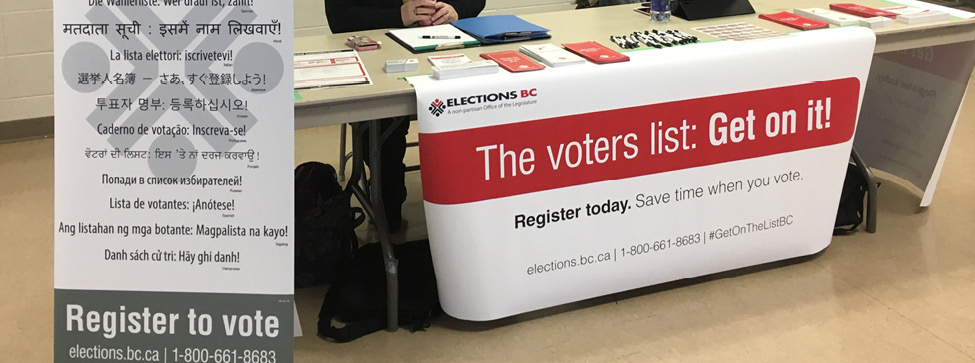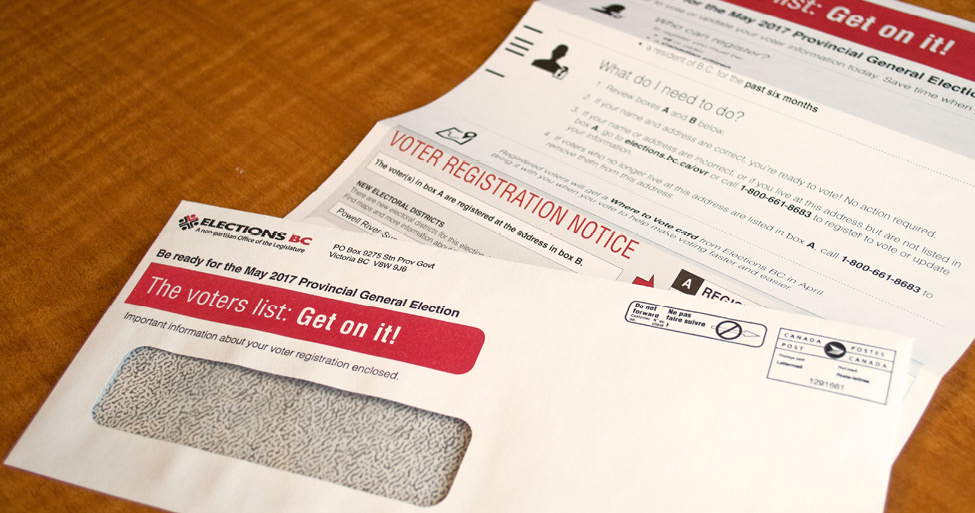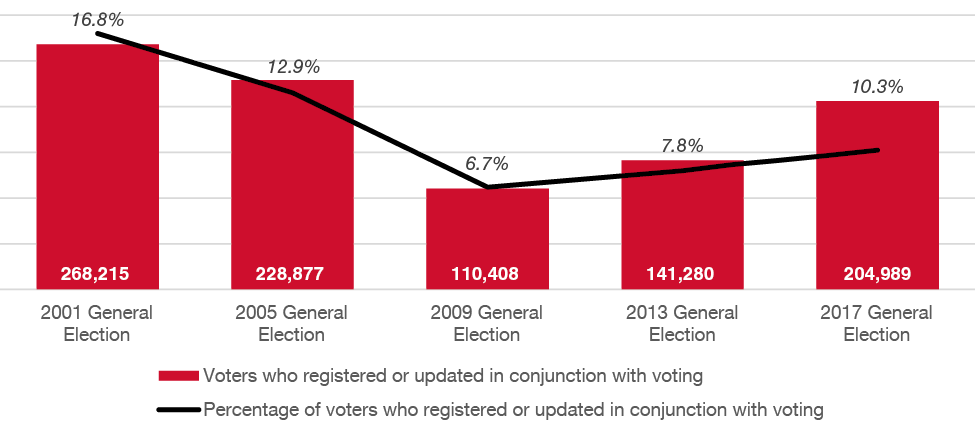- In this section
- 2017 Enumeration
- Strategies and methods
- Public information and communications
- Registration in conjunction with voting
- Outcomes
- Page Navigation
- PREVIOUS | NEXT
2017 Enumeration
In February and March, Elections BC conducted an enumeration to update the voters list to prepare for the 2017 Provincial General Election. An accurate voters list is essential for an inclusive, accessible and fair general election, and Elections BC recognizes that voters who are not registered at their current residential address face greater administrative barriers to voting. An accurate list increases the speed at which voters can be processed, so improving the quality of the voters list is part of the voter-centric model of election administration practiced by Elections BC. The voters list is also provided to candidates and political parties who use it to contact voters.
Registered voters receive personalized Where to Vote cards during an election to tell them where and when they can vote. The cards are also used by election officials to administer voting quickly and efficiently. Voters who are not registered at their current address will not receive a personalized Where to Vote card and must register or update their voter information when they vote.
While Elections BC maintains a high-quality voters list, the quality is not universally high across all electoral districts and demographics. The 2017 Enumeration sought to address this by conducting voter registration activities that would reach all eligible voters in B.C. while also targeting specific demographic and geographic groups. During the enumeration period Elections BC staff visited locations where eligible voters are less likely to be registered such as new developments and high mobility areas, as well as facilities that serve the homeless, post-secondary institutions, ethnic communities and First Nations communities.

Voters list quality is determined using the following measures:
|
Measurement |
Definition |
|
Coverage |
The percentage of eligible voters on the voters list. Also called completeness. |
|
Currency |
The percentage of voters on the voters list who are registered at the correct residential address. |
|
Net currency |
The percentage of eligible voters registered at the correct residential address. |
Elections BC had three main goals for the 2017 Enumeration:
- To achieve a level of voters list quality equal to or better than that achieved at the close of general registration prior to the 2013 Provincial General Election.
- At least 95% coverage and 93% currency, for a net currency of 88% province-wide.
- At least 65% coverage for voters 18 to 24 years of age.
- At least 85% coverage in all regions of the province.
- To determine the effectiveness of different targeted enumeration approaches, as measured through the number of updates and new registrations attributable to each approach.
- To use resources effectively by conducting targeted voter registration activities in all electoral districts in a manner that addressed the unique characteristics of each district.
Strategies and methods

Building on the successful strategy of the 2013 Enumeration, district electoral officers (DEOs) and deputy district electoral officers (DDEOs) developed a customized enumeration plan for their electoral district. This leveraged the experience and local knowledge of DEOs and DDEOs, and established voter registration strategies and techniques that fit the unique characteristics and challenges of each electoral district.
As background, DEOs and DDEOs developed an electoral district profile that listed all major commercial centres, ethnic communities, First Nations communities and education institutions in their district, as well as areas of high mobility and new residential growth. District profiles were used to develop an electoral district enumeration plan that outlined the number and types of enumeration activities to be conducted in communities throughout the district. The final enumeration plan for each electoral district was tailored to the district’s unique needs, though built on the same principles and methods across the province.
On March 1, 2017, 49 district electoral offices were established across the province to manage the conduct of enumeration activities.
Field activities
Between March 8 and March 25, Elections BC conducted a series of on-the-ground enumeration activities targeted to areas of the province and voter groups characterized by lower than average registration rates. DEOs employed teams of enumerators in each electoral district to conduct various field registration activities, including door-to-door enumeration, registration drives, site-based voting area (SVA) enumeration, and community outreach and engagement activities. Province-wide, 748 enumerators were hired to conduct registration activities in the field.
Areas suitable for door-to-door enumeration were identified in the district’s enumeration plan. These areas included high-mobility areas, short term accommodations and areas of new development, such as new building complexes or subdivisions. A door-to-door target analysis study provided by BC Stats outlining areas of high mobility helped DEOs refine their enumeration plans. Residents in these areas were less likely to be registered at their current address.
Working in pairs, teams of enumerators went door-to-door in the designated areas, updating the voters list using the RegBC tablet application. If no one was available at an address, enumerators left a “Sorry we missed you” card and information brochure directing residents to other registration opportunities. Across the province, over 170,000 residences were visited by door-to-door enumerators.
In areas where door-to-door enumeration was not practical, DEOs identified the best locations in their electoral district to conduct registration drives. Registration drives also presented an opportunity for Elections BC to gain a visible presence in the community and take voter registration services to voters. Registration drives were held in public places like high-rise apartment and condo lobbies, shopping centres, recreation facilities and libraries. Enumerators at registration drives used tablets loaded with the RegBC application to register voters and update voter information efficiently and securely.
Enumerators also provided registration opportunities to residents of site-based voting areas (SVAs). SVAs are established in locations such as long-term care or other facilities where voters are permanent residents, and where voters would be significantly challenged to attend other regular voting opportunities.
Enumerators visited each SVA to ensure that all resident eligible voters had an opportunity to register or update their voter registration. On General Voting Day, mobile voting teams visited each SVA to conduct voting. Together, SVA enumeration and mobile voting allow voters who may otherwise be unable to vote to cast their ballot. Approximately 18,000 registrations and updates at SVAs were conducted during the 2017 Enumeration.
Community outreach activities were conducted to engage groups typically under-represented on the voters list. DEOs reached out to First Nations communities and other ethnic, cultural and demographic groups in the electoral district that they felt could benefit from a community outreach event.
Outreach events were tailored to meet the needs of each target community, and offered registration opportunities and highlighted voting and employment opportunities related to the general election. DEOs worked closely with community leaders and facility administrators to ensure that these events were well promoted. DEOs and DDEOs typically played a more central role in these activities in order to establish and strengthen relationships between Elections BC and the community.
More information about Elections BC’s youth and community outreach programs can be found in section 4 of this report.
Public information and communications
Enumerators, DEOs and DDEOs were supported in the field by Elections BC headquarters staff in Victoria. In addition to planning, training and developing technology in preparation for the 2017 Enumeration, headquarters staff conducted a public awareness campaign and operated a call centre during the enumeration period.
Registration notice
A key piece of the enumeration public awareness campaign was the voter registration notice. Notices were sent to two million residential addresses across the province, listing voters registered at the address and urging eligible voters to register or update their information if needed by the close of general voter registration on April 11. The notices asked recipients to review the personal information included in the notice for accuracy and take action if needed. Three versions of the notice were distributed.

The majority of notices were sent to mailing addresses in B.C. where at least one voter was registered. This notice listed the voters registered at the address and instructed them to register or update online or by phone if any registration information was incorrect or incomplete.
A second version of the notice was sent to residential addresses with no registered voters. These notices stated that there were no registered voters at the address and instructed recipients to register online or by phone, provided they met the eligibility requirements.
The third version of the notice was sent to non-civic addresses with no registered voters. Non-civic addresses include post-office boxes and general delivery mailboxes. This notice encouraged recipients who were eligible voters to take action to ensure their voter registration was up to date.
All notices were mailed between February 14 and March 8. Elections BC used Canada Post’s Point-of-Call database to target only valid mailing addresses, avoiding the cost of sending enumeration notices to addresses where mail could not be delivered.
|
Notice type |
Number mailed |
|
Mailing addresses with registered voters |
1,670,272 |
|
Civic addresses with no registered voters |
302,573 |
|
Non-civic addresses with no registered voters |
19,633 |
Advertising
Elections BC developed a comprehensive communications strategy to increase public awareness and engage voters in the lead-up to the 2017 Provincial General Election. During the enumeration period, Elections BC incorporated digital, radio, print and television advertising with a proactive social media campaign.

The enumeration public awareness campaign, which ran from February 14 to March 31, promoted voter registration and supported Elections BC’s field activities and outreach. The campaign, themed “I Register”, encouraged eligible voters to register online or by phone before the close of general registration on April 11. Television, radio and print advertising featured British Columbians of diverse backgrounds. One of B.C.’s best-known sports figures, Trevor Linden, was also featured in the ads. To target young people and other groups less likely to register and vote, printed ads were posted on Skytrain platforms, in buses province-wide, and in restaurants and bars.
Website
During the enumeration, the Elections BC website highlighted relevant information about the new electoral district boundaries, planned registration activities taking place in communities throughout B.C., and voter eligibility criteria.
Before the voters list closed on Writ Day, eligible voters could register or update their voter information online using the Online Voter Registration system (OVR). Links to OVR were featured prominently throughout Elections BC’s website, public awareness advertisements and social media posts. Per the requirements of the Election Act, OVR was unavailable after April 11 and eligible voters who needed to register or update were directed to do so when they voted.
Social media
Social media was a major component of the public awareness campaign during the enumeration. Elections BC shared images and videos consistent with the traditional media campaign on Facebook, Twitter and YouTube. A first for an electoral management body in Canada, Elections BC also expanded its social media presence to include Instagram.
The social media campaign was integrated with Elections BC’s traditional registration activities. Elections BC used social media to promote voter registration online and by phone using the hashtags #IRegister and #GetOnTheListBC, generating 5.6 million impressions and reaching 1.7 million British Columbians on Twitter alone. Social media and other online advertising drove over 20,000 trackable clicks to OVR.
One new initiative was the use of the “button board” at campus-based registration drives. People were invited to take an “I Register” button from the board, revealing the campaign message and hashtag #GetOnTheListBC. A time-lapse video was taken of the button board and shared on social media.

During the enumeration period, Elections BC’s social media followers grew by 79% on Facebook and 20% on Twitter.
Contact centre
To handle the increased call volume during the enumeration period, Elections BC established a contact centre at its headquarters in Victoria. Contact centre staff processed voter registrations and updates and fielded questions and comments from the public. During the enumeration period, the contact centre performed 72,869 voter record transactions, resulting in 34,882 new registrations and updates. The contact centre remained open through the election period until shortly after General Voting Day.
More information about Elections BC’s public information and communications activities during the general election period can be found in section 4 of this report.
Registration in conjunction with voting
After the close of the voters list on April 11, voter registration was only available in conjunction with voting. Voters who wished to register in conjunction with voting were required to prove their identity and residential address to register and vote.
There were 204,989 registrations and updates in conjunction with voting, resulting in 89,656 new registrations and 115,333 updates. There were an additional 8,714 “just in case” registrations in conjunction with voting, where the transaction resulted in no changes to a voter record. At the close of voting on General Voting Day, there were 3,246,647 registered voters on the voters list.

Outcomes
During the enumeration period, more than 135,000 voters list transactions resulted from enumeration activities. An additional 240,000 voters list transactions were processed through the call center, by the Online Voter Registration (OVR) system, or were unrelated to the enumeration and resulted from operational activities during this period, such as updates from the National Register of Electors, ICBC and Vital Statistics.
|
Source |
Registrations |
Removals |
Updates |
Confirmations |
Total |
|
Total |
45,255 |
47,282 |
172,231 |
112,645 |
377,413 |
|
OVR |
31,014 |
0 |
69,152 |
5,371 |
105,537 |
|
Contact centre |
4,886 |
29,088 |
29,996 |
8,899 |
72,869 |
|
Field enumeration activities |
9,320 |
9,845 |
30,064 |
86,721 |
135,950 |
|
Other* |
35 |
8,349 |
43,019 |
11,654 |
63,057 |
* Other sources include address updates from ICBC, death notifications from the BC Vital Statistics agency, administrative processes such as deduplication, and all information received via email, mail and fax.
Assessing enumeration results
Overall coverage, currency and net currency
Elections BC contracted BC Stats to conduct the 2017 Voters List Quality Study to measure the quality of the voters list at three points: before the start of the enumeration (January 19, 2017), after the close of general registration (April 11, 2017), and on General Voting Day (May 9, 2017). BC Stats conducted a comprehensive assessment of the currency of the list as of May 9, 2017 by combining information from the enumeration and election with information from a survey of registered voters. An estimate of currency at the start of the enumeration and at the close of general registration was produced by analyzing additions, deletions and changes to records on the voters list that took place between January 19 and April 11, and between April 11 and May 9.
To calculate coverage, BC Stats estimated the number of eligible voters in each electoral district by using population counts collected during the 2011 Census and administrative and survey data collected in conjunction with the 2016 Census. More information on the methods used to calculate coverage is included in the report on the 2017 Voters List Quality Study from BC Stats, scheduled to be published in spring 2018.
|
2013 |
2017 |
|||||
|
Measurement |
Start of enumeration |
Close of general registration |
Close of voting |
Start of enumeration |
Close of general registration |
Close of voting |
|
Coverage |
96.3% |
95.1% |
96.9% |
92.1% |
91.8% |
94.4% |
|
Currency |
89.4% |
92.7% |
94.2% |
86.1% |
91.5% |
94.1% |
|
Net currency |
86.1% |
88.2% |
91.3% |
79.3% |
83.4% |
88.8% |
Following the pattern seen in 2013, voters list coverage decreased during the enumeration, as the 45,255 registrations received between January 19 and April 11 were outpaced by 47,282 removals. While currency and net currency increased through the 2017 Enumeration, the levels of coverage, currency and net currency at the close of general registration fell short of the levels achieved in 2013.
A significant factor in the reduced level of voters list quality from 2013 was a lower quality list at the beginning of the enumeration period. The seven-point reduction in net currency between the start of the 2013 Enumeration and the start of the 2017 Enumeration occurred despite more than two million new registrations, updates and removals between the end of the 2013 Provincial General Election and the start of the 2017 Enumeration. The 2017 Enumeration achieved greater quality improvements to currency and net currency than in the 2013 Enumeration, but the degree of list quality improvement was not enough to produce a better end result. Although the same level of list quality achieved in 2013 was not reached by the close of general voter registration in 2017, registration in conjunction with voting raised list quality to the pre-election target level.
|
2013 |
2017 |
|||
|
Measurement |
Change through enumeration period (%) |
Change through election period |
Change through enumeration period (%) |
Change through election period |
|
Coverage |
-1.2 |
+1.8 |
-0.3 |
+2.6 |
|
Currency |
+3.3 |
+1.5 |
+5.4 |
+2.6 |
|
Net currency |
+2.1 |
+3.1 |
+4.1 |
+5.4 |
Coverage by region
Coverage levels in each region of the province were also estimated in the 2017 Voters List Quality Study. Elections BC’s goal was to achieve at least 85% coverage in every region of the province by the close of general registration on April 11, which was achieved in all regions. The lowest coverage level was in the North, at 85%.
Youth coverage
Elections BC’s goal of achieving coverage of 65% of voters aged 18-24 at the close of general registration was not achieved. The estimated coverage as of April 11 of voters aged 18-24, based on voter data and BC Stats estimates, was 58%. The coverage of 18-24 year-olds rose to 68% at the close of voting on May 9, 2017, due to voters who registered in conjunction with voting.
Determining the effectiveness of targeted enumeration approaches
One goal of the 2017 Enumeration was to determine the effectiveness of different targeted enumeration approaches, as measured through the number of updates and new registrations attributable to each approach. A benefit of using the RegBC tablet application to track enumeration activities is that Elections BC has rich operational data about the effectiveness of each activity to help plan future activities.
|
Enumeration approach |
Registrations |
Removals |
Updates |
Confirmations |
Total transactions |
|
Door-to-door |
4,120 |
8,128 |
8,036 |
58,765 |
79,049 |
|
Outreach visits and |
3,331 |
146 |
5,950 |
12,658 |
22,085 |
|
Site-based voting areas |
1,869 |
1,571 |
16,078 |
15,298 |
34,816 |
|
Total |
9,320 |
9,845 |
30,064 |
86,721 |
135,950 |
Each type of voters list transaction has a different effect on list quality. Registrations improve both coverage and currency by adding new voters to the list at their current address. Removals are applied to records of voters who no longer live at an address or who have died, improving currency by removing non-current voters from the list, while also reducing coverage. Updates are applied to voters whose name or address have changed. Updates improve currency by moving voters from a non-current address to a current address and have no effect on coverage. Voter record confirmations are applied to indicate that a record is correct as-is. These transactions are administratively useful, but they do not improve the coverage or currency of the voters list.
Door-to-door enumeration accounted for nearly 60% of enumeration activities and a similar proportion of overall field enumeration transactions, but around 75% of these transactions were confirmations that had no effect on list quality. The biggest challenge reported by enumerators and evident in tracking data was that at approximately 75% of homes visited by enumerators, doors went unanswered. While door-to-door activities were more effective in some areas than others, there was little variation in door-answer rates at different times of day.
Outreach visits to post-secondary institutions, First Nation communities, homeless service facilities and ethnic communities represented a small but important component of registration activities. These activities brought registration opportunities to communities that experience barriers to accessing other registration channels.
Registration drives and outreach visits accounted for 29% of enumeration activities and 24% of new registrations and updates. Building on enumerator experiences in 2013, higher-traffic locations were targeted for registration drives, and proactive engagement with voters was emphasized during enumerator training in 2017, resulting in more transactions at registration drives and outreach visits than in 2013.
Enumeration in site-based voting areas (SVAs) was highly effective. Most SVAs are residential care facilities with a higher density of residents than typical door-to-door routes, more staff assistance available than at most outreach visits, and higher turnover than at most residences. SVA enumeration accounted for only 12% of enumeration activities, but over 45% of new registrations and updates. Because of the importance of an up-to-date voters list in administering mobile voting procedures to SVA residents, SVA enumeration continues to be a crucial element of administering elections in B.C.
Making effective use of resources in all electoral districts
One of Elections BC’s goals for the 2017 Enumeration was to make effective use of resources by conducting targeted voter registration activities in all electoral districts in a manner that addressed the unique characteristics of each district. The planning exercises and electoral district profiles completed by DEOs and DDEOs ahead of the enumeration period enabled Elections BC to achieve this goal and contributed to the success of the 2017 Enumeration.

